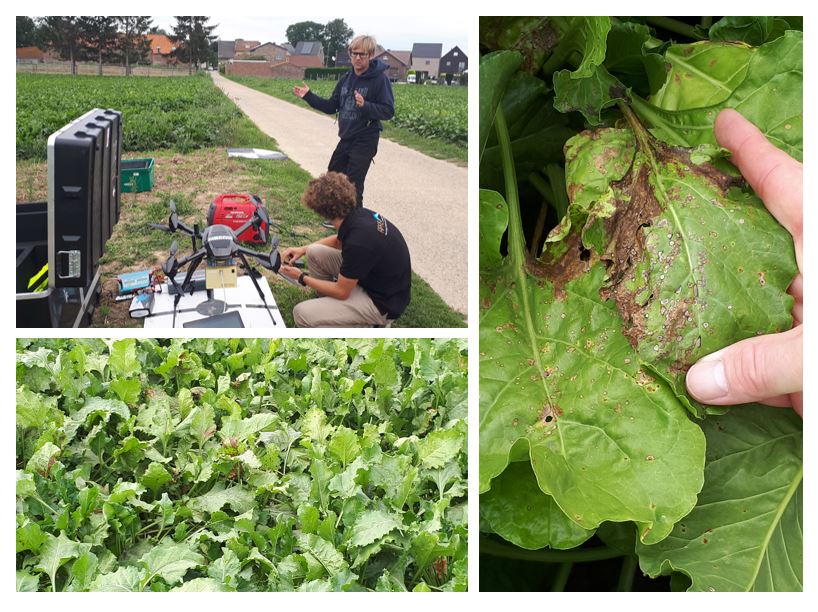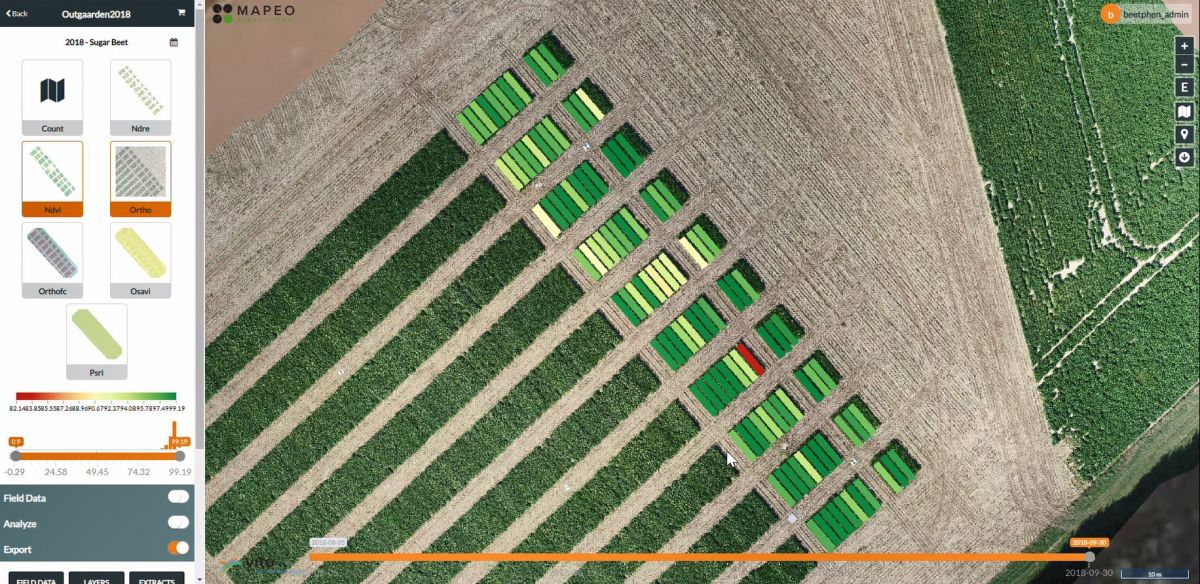Unravelling the spectral signals of sugar beet plants captured by drones.
Sugar beet seed companies have thousands of field trials around the world where seeds can be tested under the local climatic and production systems. In cooperation with experienced local growers, experimental hybrids are tested along side the best approved varieties to confirm whether these new varieties perform better than the control varieties. During the growing season, field experts monitor the different plots for emergence, tolerance to pests, disease and bolting, along with other plant characteristics. This is a labor and time-intensive job. We therefore tested an innovative way to ease this monitoring job by using drones. This way, we could capture field data in a more efficient, accurate and homogeneous way. A dedicated machine learning based image processing chain for sugar beet disease detection was developed. Applying these processing steps resulted in easily interpretable maps that support decision making for the sugar beet experts.
Monitoring experimental varieties over the world
To boost productivity and ensure food security, we need to protect our crops. The use of disease-resistant crop varieties represents an important means to this end, as it largely avoids the large-scale application of insecticides. Although effective, this strategy comes with certain challenges, as pathogens constantly adapt to changing crop varieties and new diseases get introduced. Seed breeders are therefore always in search for new, disease-resistant cultivars to help farmers grow productive and healthy crops in a sustainable way.
To support this search for disease-resistant crop varieties, BELSPO initiated the BEETPHEN project. Together with SESVanderHave and CRA-w we evaluate the use of hyperspectral drone imagery and innovative remote sensing technology for crop phenotyping in sugar beet breeding trials.
Welcome to the world of seed breeders
Seed breeding companies, including SESVanderHave, a leading global player in the sugar beet seed sector, have thousands of field trials around the world where the performance of different varieties can be tested under local climatic and management conditions. In cooperation with experienced local growers, the productivity and resistance to diseases of newly developed, experimental varieties are constantly compared to those of long established varieties known to perform well in the given circumstances.
 Throughout the growing season field experts continuously monitor the different plots analyzing emergence, tolerance to pests, diseases and bolting, along with other plant characteristics. Given the sheer amount of trials and characteristics, this process is rather time- and labor intensive. In addition, a comparison of observations between different local experts typically reveals an extensive degree of mismatches due to the subjective nature of the scoring protocols.
Throughout the growing season field experts continuously monitor the different plots analyzing emergence, tolerance to pests, diseases and bolting, along with other plant characteristics. Given the sheer amount of trials and characteristics, this process is rather time- and labor intensive. In addition, a comparison of observations between different local experts typically reveals an extensive degree of mismatches due to the subjective nature of the scoring protocols.
Many seed breeders are therefore looking into new and innovative technologies, including drone-based technology, to improve their classical monitoring and scoring process. In the Beetphen project, we teamed up with SESVanderHave and CRA-w to evaluated the use of hyperspectral drone imagery and innovative remote sensing technology for crop phenotyping in sugar beet breeding trials.
From classical scoring to drone-based phenotyping
Drone imagery has been revolutionary for many agricultural research applications due to its relative low cost and high degree of objectivity. To develop an easy-to-use, objective and efficient disease detection tool for sugar beet seed breeders we compared high-end drone-based image processing solutions to time- and labor intensive ground-based field observations of various diseases, such as powdery mildew.
By using high-resolution spectral sensors on board of drones we can capture detailed plant information in an efficient, accurate and homogeneous way and analyze the impacts of various external factors on plant growth. Once all drone data is captured, it of course does not (yet) process itself. To support the sugar beet experts in extracting the necessary information from the imagery, we developed a dedicated machine learning based image processing chain specifically for sugar beet disease detection. The algorithm screens the imagery for symptoms and returns a user friendly color coded map indicating the plants’ health status.

MAPEO, creating a digital twin of your field trials
These maps are provided via our online platform for drone based high-throughput phenotyping ‘MAPEO’. In essence, MAPEO translates drone images into the users’ needs, making the required information readily available through a user-friendly web-based interface. MAPEO allows farmers and breeders to use innovative and high-end remote sensing technology without being confronted with the complexities thereof and focus on what is truly important to them, searching the best disease-resistant seed varieties.
MAPEO provides a wealth of information, even information that originally cannot be seen with the naked eye, ensuring better-founded farm management or breeding decisions. It allows agricultural field managers to accurately and efficiently monitor the disease resistance of different sugar beet varieties, optimizing effort and cost, and speeding up associated cultivation and selection programs.

The research presented in view of the Beetphen project is funded by BELSPO (Belgian Science Policy Office) in the frame of the STEREO III programme – project BEETPHEN (SR/00/346).

